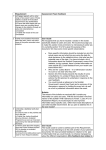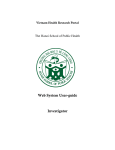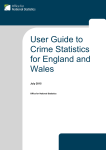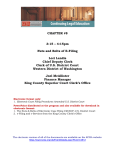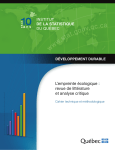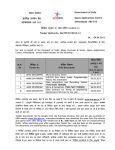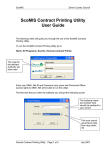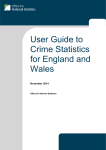Download User Guide to Recorded Crime Statistics in Scotland
Transcript
User Guide to Recorded Crime Statistics in Scotland Justice Analytical Service September 2014 CONTENTS Page 1. Introduction .......................................................................................................... 3 2. Police Reform ...................................................................................................... 4 2.1 2.2 2.3 2.4 2.5 The Origins of Police Reform ........................................................................ 4 Consultation on Police Reform ...................................................................... 4 Police Scotland .............................................................................................. 5 Scottish Police Authority ................................................................................ 5 Her Majesty's Inspectorate of Constabulary in Scotland ............................... 6 3. Roles of Organisations ......................................................................................... 6 4. Policies and Procedures ...................................................................................... 6 5. Scottish Crime Recording Standard - Crime Recording and Scottish Government Counting Rules ........................................................................................................... 7 6. Crime Registrars – Structure and Meeting Arrangements.................................... 7 7. Data Quality ......................................................................................................... 8 7.1 7.2 7.3 Police Scotland Audits ................................................................................... 8 Her Majesty's Inspectorate of Constabulary in Scotland Audits..................... 8 Technical Report on the Comparability of Recorded Crime Data .................. 9 8. No Criming ........................................................................................................... 9 9. Classification of Crimes and Offences ............................................................... 10 9.1 9.2 Crimes ......................................................................................................... 10 Offences ...................................................................................................... 14 10. Changes to Crime and Offence Classifications............................................... 16 11. Clear Up Rates ............................................................................................... 16 12. Crimes and Offences per Population Rates .................................................... 17 13. Revisions Policy.............................................................................................. 18 14. Scottish Crime and Justice Survey ................................................................. 18 14.1 Scottish Crime and Justice Survey ........................................................... 19 14.2 Comparing Police Recorded Crime and the Scottish Crime and Justice Survey ................................................................................................................. 19 15. Accessibility of Recorded Crime Data............................................................. 20 1 16. Other Statistical Bulletins Using Police Recorded Crime Data........................ 20 17. Users and Uses of Recorded Crime Statistics ................................................ 20 17.1 17.2 18. Comparability Across the UK .......................................................................... 25 18.1 18.2 18.3 19. England and Wales .................................................................................. 25 Northern Ireland ....................................................................................... 26 Internationally ........................................................................................... 26 Consultations .................................................................................................. 26 19.1 20. Users of the Recorded Crime Statistics.................................................... 20 Uses of Recorded Crime Statistics........................................................... 21 Survey of Users of Crime and Justice Statistics Website ......................... 27 Potential Future Considerations...................................................................... 27 20.1 20.2 Individual Level Data ................................................................................ 27 Frequency of Releases ............................................................................ 27 2 1. Introduction This user guide provides detailed information on the Recorded Crime in Scotland statistical bulletin, published by the Scottish Government, and the data that are contained in the bulletin. It is designed to be a useful reference guide with explanatory notes regarding the updates, issues, and classifications which are crucial to the production and presentation of crime statistics in Scotland. The Scottish Government publishes figures on the levels and trends of crime in Scotland primarily based on two sets of crime statistics: the police recorded crime data and the Scottish Crime and Justice Survey (SCJS). Each source has different strengths and limitations but together they provide a more comprehensive picture of crime than could be obtained from either series alone. Further information on the SCJS can be accessed here: http://www.scotland.gov.uk/Topics/Statistics/Browse/Crime-Justice/crime-and-justicesurvey The statistical return from which most of the figures in the Recorded Crime bulletin are taken is a simple count of the numbers of crimes and offences recorded and cleared up by the police in Scotland. Only data from the Police Service of Scotland, hereafter referred to as Police Scotland throughout this user guide, are included in the main findings and tables included in the bulletin. One return is made for each local authority in Scotland and these are aggregated to give a national total. Additionally, data on the total number of crimes and offences recorded and cleared up by the British Transport Police, the Ministry of Defence Police and the Civil Nuclear Constabulary in Scotland are included in the Statistical Notes section of each bulletin In addition to the annual Recorded Crime in Scotland bulletin a number of companion bulletins based on police recorded crime data are published by the Scottish Government on homicide, domestic abuse, crimes and offences involving firearms and racist incidents. Furthermore bulletins on drug seizures, firearm certificates and police officer numbers are published by the Scottish Government on data collected from Police Scotland. Together these statistics are used to inform National Outcome 9 – ‘we live our lives safe from crime, disorder and danger’ as well as The Strategy for Justice in Scotland. These statistics are also used by a wide range of stakeholders to monitor trends, for policy research and development, and for research purposes. In July 2014 the UK Statistics Authority published an assessment of Statistics of Recorded Crime in Scotland. Having assessed the statistics based on police recorded crime data against the Code of Practice for Official Statistics, the Authority cannot, at present, confer the designation of Recorded Crime in Scotland as National Statistics. Scottish Government statistical bulletins based on police recorded crime data can be accessed from the publications area of the Crime and Justice Statistics section of the Scottish Government website at: http://www.scotland.gov.uk/Topics/Statistics/Browse/Crime-Justice/Publications For further information about Recorded Crime in Scotland, please email [email protected]. 3 Crime statistics for England and Wales and Northern Ireland are collected and published separately. The latest police recorded crime data for England and Wales and Northern Ireland can be accessed here: • England and Wales: http://www.ons.gov.uk/ons/rel/crime-stats/crimestatistics/index.html; • Northern Ireland: http://www.psni.police.uk/index/updates/updates_statistics.htm. 2. Police Reform The Police and Fire Reform (Scotland) Act 2012 changed the policing landscape in Scotland, replacing the previous eight police forces, the Scottish Police Services Authority and the Scottish Crime and Drug Enforcement Agency. The Police Service of Scotland (hereafter referred to as Police Scotland throughout this report) is now responsible for operational policing in Scotland and will be held to account by the Scottish Police Authority. 2.1 The Origins of Police Reform Examination of the case for reforming our police services began with the publication of the report of the Independent Review of Policing by Her Majesty’s Chief Inspector of Constabulary for Scotland, Paddy Tomkins, in 2009 under the auspices of the Scottish Policing Board. In 2010 the police service began examining options for maintaining an effective frontline service with reduced funding as a result of the worsening prospects for public expenditure. The Sustainable Policing Team, of police officers and staff supported by Scottish Government officials, prepared a report on the options. 2.2 Consultation on Police Reform The first police reform consultation “A Consultation on the Future of Policing in Scotland” was launched on 10 February 2011. The first consultation sought views on how to protect and improve the police service, including ways to create better partnership working with other organisations, and on future structural options for the police service. An analysis report of this consultation was published on 21 June 2011. After a series of consultation events and substantive engagement with key stakeholders on the case for police reform in the summer of 2011, on 8 September 2011 the Cabinet Secretary for Justice, Kenny MacAskill, announced in Parliament the Scottish Government’s intention to legislate for a single police service. Along with this announcement a consultation paper – “Keeping Scotland Safe and Strong: A Consultation on Reforming Police and Fire and Rescue Services in Scotland” was published, setting out the Scottish Government’s proposals for how best to establish the single police and fire and rescue services and inviting comments to help shape the final proposals and legislation. This consultation received 145 written responses consultation responses and a consultation analysis report was published on 10 February 2012. 4 The Police and Fire Reform (Scotland) Bill 2011 was formally introduced in Parliament on 12 January 2012 by the Cabinet Secretary for Justice, and became an Act in August 2012. The Bill and its details of its passage through Parliament are available on the Scottish Parliament website. On 21 February 2012, the Justice Secretary announced that the Police Scotland would become operational on 1 April 2013. More detail on the legislation behind the reform and consultations undertaken can be accessed here: http://www.scotland.gov.uk/Topics/Justice/policies/police-firerescue/police-scotland/LegislationPoliceServiceofScotland 2.3 Police Scotland Police Scotland was formally established on 1 April 2013 and is responsible for policing across the length and breadth of Scotland, some 28,168 square miles. Police Scotland is the second largest force in the UK after the Metropolitan Police. The Service is led by Chief Constable Stephen House and comprises police officers, police staff and special constables who are working together to deliver the best possible policing service for the people of Scotland. The Chief Constable is supported by a command team of four Deputy Chief Constables, Assistant Chief Constables and three Directors. There are 14 local policing divisions, each headed by a Local Police Commander who ensures that local policing in each area is responsive, accountable and tailored to meet local needs. Alongside the local policing divisions, there are a number of national specialist divisions. The Specialist Crime Division (SCD) provides specialist investigative and intelligence functions such as Major Crime investigation, Public Protection, Organised Crime, Counter Terrorism, Intelligence and Safer Communities. Police Scotland’s priorities are outlined in their Annual Police Plan and ensure that they are delivering a service which is focused on Keeping People Safe. The priorities in Police Scotland’s Annual Police Plan are aligned to the strategic police priorities set by the Scottish Government and the strategic objectives outlined by the Scottish Police Authority in their three year plan. They are also informed by the local policing plans set at local authority and multi member ward levels. Police Scotland took over responsibility for policing in Scotland from the eight former police forces, the Scottish Crime and Drug Enforcement Agency and the Association of Chief Police Officers in Scotland. Further information on Police Scotland can be found on their website: http://www.scotland.police.uk/ 2.4 Scottish Police Authority The Scottish Police Authority (SPA) was established under the Police and Fire Reform (Scotland) Act 2012 to maintain policing, promote policing principles and continuous improvement of policing, and to hold the Chief Constable to account. The SPA Board was appointed in October 2012 and is working to ensure that the people of Scotland receive the best policing possible. The Board will do this through a robust governance approach focused on securing best value, reducing duplication and keeping police officers out in our communities and tackling crime. It will hold the Chief Constable to account for the policing of Scotland and the Chief Executive of the 5 SPA to account for its role as employer of staff and the delivery of services to the board and policing. The SPA Board has delegated responsibility to the Scottish Police Authority Chief Executive to provide support and advice to the board on strategic decisions regarding finance, human resource and any other area required. From 1 April 2013, the Chief Executive will also oversee the management of Forensic Services in Scotland to support Police Scotland to carry out operational policing. Further information on the Scottish Police Authority can be found on their website: http://www.spa.police.uk/ 2.5 Her Majesty's Inspectorate of Constabulary in Scotland Her Majesty's Inspectorate of Constabulary in Scotland (HMICS) provides independent scrutiny of both Police Scotland and the Scottish Police Authority. HMICS has wide ranging powers to look into the “state, effectiveness and efficiency” of both Police Scotland and the Scottish Police Authority, including Forensic Services. Their approach is to support Police Scotland and the SPA to deliver services that are high quality, continually improving, effective and responsive to local needs. HMICS also have a statutory duty to ensure that the Chief Constable of Police Scotland and the SPA meet their obligations in terms of best value and continuous improvement. If necessary, HMICS can be directed by Scottish Ministers to look into anything relating to the SPA or Police Scotland as they consider appropriate. HMICS also have an established role in providing professional advice and guidance on policing in Scotland. HMICS’s powers allow them to do anything they consider necessary or expedient for the purposes of, or in connection with, the carrying out of their functions. The SPA and the Chief Constable must provide HMICS with such assistance and co-operation as they may require to carry out their functions and must comply with any reasonable request that they make. When HMICS publish a report, the SPA and the Chief Constable must also consider what HMICS have found and take such measures, if any, as they think fit. Where HMICS make recommendations, they will follow them up and report publicly on progress. HMICS aim to add value and strengthen public confidence in Scottish policing and will do this through independent scrutiny and objective evidence-led reporting about what they find. Where relevant, HMICS will make recommendations to Police Scotland and the SPA that aim to improve policing. HMICS will also identify good practice that can be rolled out across Scotland. Further information on HMICS can be found on their website: http://www.hmics.org/ 3. Roles of Organisations (To be completed) 4. Policies and Procedures (To be completed) 6 5. Scottish Crime Recording Standard - Crime Recording and Scottish Government Counting Rules On 1 April 2004, the Scottish Crime Recording Standard (SCRS) was introduced throughout Scotland. The SCRS was produced by the Scottish Crime Registrar’s Group and agreed by Association of Chief Police Officers in Scotland (ACPOS), following research that identified the need to develop a more victim orientated approach to crime recording. This followed on from the National Crime Recording Standard, which was introduced in England and Wales in April 2002. The Counting Rules provide a national standard for the recording and counting of crimes and offences recorded by Police Scotland, known as 'recorded crime'. The Rules were devised to take account of the SCRS with the aim of providing a more victim orientated approach to the recording of crime and ensuring uniformity in crime recording standards across Scotland. The ultimate responsibility for ensuring compliance lies with the Chief Constable of Police Scotland, discharged on a daily basis by the appointed Crime Registrars. All crime records are subject to the rules set out in the SCRS which are under constant review. Updates to the Counting Rules will normally be effective from 1 April each year The SCRS is published by Police Scotland in the 'Our Performance' section of their website under Related Documents and can be accessed here: http://www.scotland.police.uk/about-us/our-performance/. The crimes and offences data included in the following statistical bulletins published by the Scottish Government are recorded according to the SCRS: • • • • • 6. Recorded Crime in Scotland Domestic Abuse Recorded by the Police in Scotland Homicide in Scotland Racist Incidents Recorded by the Police in Scotland Recorded Crimes and Offences Involving Firearms Crime Registrars – Structure and Meeting Arrangements A new crime registrar structure was put in place following the establishment of Police Scotland on 1 April 2013, together with the roles of the national crime registrar and three regional crime registrars. As well as having regional responsibilities, these three registrars each lead on a specific aspect of crime recording: training; audit; and maintaining the Counting Rules. The three registrars are managed by the national crime registrar. The crime registrar role is under regular scrutiny and a number of improvement actions have already been progressed. However a formal review will not commence until October 2014. Representatives of the Scottish Government JAS Division are members of the Scottish Crime Registrars’ Group. This group was established to support consistency in implementing the SCRS and associated Counting Rules. The group discusses matters arising from the application of the SCRS and is also responsible for maintaining and updating the Counting Rules. 7 7. Data Quality Within the Scottish Government, the Justice Analytical Services (JAS) Division is responsible for the collection, quality assurance and publication of police recorded crime statistics. A wide range of mechanisms are employed to ensure the robustness of police recorded crime data. The data that were collected from the legacy police forces were collected on a cumulative quarterly basis and a number of detailed quality assurance checks were carried out by JAS. This included the checking of data across the cumulative quarters to ensure data consistency as the year progresses; checking data across legacy police force areas to ensure consistency and confirming local differences; and comparing figures year on year, investigating where substantial differences appear. With the establishment of Police Scotland and their new performance management system ScOMIS brings the ability to extract information in a much more efficient way. This has allowed Police Scotland to submit the recorded crime data in actual quarters and not on a cumulative quarterly basis. This only allows the potential for Police Scotland to submit revised quarters throughout the financial year. In addition to the rigorous quality assurance work that is already undertaken, JAS can now quality assure the individual quarters. This has the advantage that any revisions made to the data after initial submission to the Scottish Government can be applied to the relevant quarter and not applied cumulatively to the data as a whole. This should allow the discovery of anomalies within individual quarters to be more straightforward. If any issues with the data are found they are referred back to the appropriate points of contact within the police to ensure that anomalies are addressed and that the final resulting data are an accurate reflection of police activity within each financial year period. 7.1 Police Scotland Audits (To be completed) 7.2 Her Majesty's Inspectorate of Constabulary in Scotland Audits HMICS conducts national reviews of incident and crime recording, with one of the aims being to assess compliance with crime recording standards. The most recent such review was conducted just after the creation of the Police Scotland, on 1 April 2013. The HMICS Review of Incident and Crime Recording was published in December 2013. The report of the review can be can be accessed here: http://www.hmics.org/publications/hm-inspectorate-constabulary-scotland-reviewincident-and-crime-recording-december-2013 HMICS are currently in the process of conducting a crime recording audit. The aim of the crime audit is to test the accuracy of incident and crime recording in Scotland. The results will: • Provide the public and key stakeholders with greater information on which to base their assessment of the trustworthiness and validity of crime statistics; 8 • Highlight to Police Scotland areas of good practice or areas for improvement and/or increased internal audit and scrutiny; • Assess the extent to which recommendations made in our 2013 review of incident and crime recording have been taken into account; and • Address the need for a comprehensive, independent audit of crime data as highlighted by the UK Statistics Authority. The result of the audit is due to be published in late October 2014. The full terms of reference of the crime audit can be accessed here: http://www.hmics.org/publications/hmics-crime-audit-2014-terms-reference. 7.3 Technical Report on the Comparability of Recorded Crime Data In preparation for the launch of Police Scotland, a new IT system (ScOMIS) was put in place up to allow crime reports to be collated from the variety of systems used by the eight legacy police forces, into one central management system. Previously, the eight legacy forces submitted data to the Scottish Government’s Justice Analytical Services (JAS) Division which was then subject to quality assurance in preparation for publication in the bulletin series, Recorded Crime in Scotland. At present, the Scottish Government holds comparable crime data which goes back to the 1930’s. However, as data will now be extracted from the ScOMIS system, it was essential that the Scottish Government assessed whether data for 2013-14 onwards were comparable with the existing time series; and where differences exist, why those differences occur. The technical report details the quality assurance work carried out by Scottish Government with the support of Police Scotland, for each separate crime and offence group. This has allowed decisions to be made about the comparability of ScOMIS data with data previously supplied by legacy police forces. Data for five years prior to the establishment of Police Scotland were analysed. 8. No Criming The police record some crimes which are subsequently ‘no crimed’ where it is determined by the police that no crime actually took place. The Scottish Crime Recording Standard (SCRS) set out circumstances under which a crime report may be ‘no crimed’. These include situations where, having been recorded, additional credible information becomes available that determines that no crime was committed or the crime was committed outside the jurisdiction of Police Scotland, for further information please see Section E of the SCRS. ‘No crimes’ relate to crimes already recorded and are therefore distinct from incident reports that are not recorded as crimes in the first place. Crime reports that are ‘no crimed’ are removed from police crime data and thus from the police recorded crime statistics. The majority of ‘no crime’ decisions are made by the police before data are submitted to the Scottish Government. Great care is needed in interpreting ‘no crime’ data. The proportion of ‘no crimes’ does not in itself infer high or low compliance with the overall requirements of the SCRS. Levels of ‘no criming’ are particularly susceptible to local recording practice 9 and the legacy IT systems in use. A legacy police force area having a high level of ‘no crimes’ may be indicative of that legacy force area having a local recording process that captures all reports as crimes at the first point of contact and before any further investigation has taken place to consider the full facts. Equally a legacy police force area with a low level of ‘no crimes’ might be indicative of a recording practice by which reports are retained as incidents only until a fuller investigation has taken place. 9. Classification of Crimes and Offences Shown below are the seven crime groups split into the 32 crime and offence categories that are used in the presentation of recorded crime data. The main types of crimes and offences that each top 32 category consists are also shown. A full list of all the crimecodes, around 475, used by the Scottish Government to classify crimes and offences can be accessed in Excel format here: (this page is not yet published) 9.1 Crimes Group 1: Non-Sexual Crimes Of (Also referred to as Crimes of Violence) Violence Homicide etc. - Attempted assault - murder Includes: • Murder • Culpable homicide - Culpable homicide (common law) - Causing death by dangerous driving - Causing death by careless driving while under the influence of drink or drugs - Causing death by careless driving - Illegal driver involved in fatal accident - Corporate homicide and serious Includes: • Attempted murder • Serious assault An assault is classified as serious if the victim sustained an injury resulting in detention in hospital as an in-patient or any of the following injuries whether or not he/she was detained in hospital: fractures, internal injuries, severe concussion, lacerations requiring sutures which may lead to impairment or disfigurement or any other injury which may lead to impairment or disfigurement. Robbery - Robbery and assault with intent to rob 10 Other - Includes: • Threats and extortion • Cruel and unnatural treatment of children • Abortion • Concealment of pregnancy • Possession of a firearm with intent to endanger life, commit crime etc. • Abduction • Ill treatment of mental patients • Drugging Group 2: Sexual Crimes Prior to 2013-14 this group was known as Sexual offences, as this corresponds to the name of the legislation implemented on 1 December 2010 covering these crimes. This led to some confusion as to whether this group was being included in crimes or offences. To emphasise that these are crimes, as they always have been, this group has been renamed Sexual crimes. The corresponding name changes have been made to the other crime categories in this group. Rape and attempted rape - Includes: • Rape • Attempted rape Sexual assault - Includes: • Contact sexual assault (13-15 year old or adult 16+) • Sexually coercive conduct (13-15 year old or adult 16+) • Sexual crimes against children under 13 years • Lewd and libidinous practices Crimes associated with prostitution - Includes: • Crimes relating to prostitution • Soliciting services of person engaged in prostitution • Brothel keeping • Immoral traffic • Procuration Other - Includes: • Other sexually coercive conduct • Other sexual crimes involving 13-15 year old children • Taking, distribution, possession etc. of 11 • • • • • Group 3: Dishonesty Crimes Housebreaking - indecent photos of children Incest Unnatural crimes Public indecency Sexual exposure Other sexual crimes Involving (Also referred to as Dishonesty) Includes: • Theft by Housebreaking domestic property (dwelling and non-dwelling) • Theft by Housebreaking other property • Housebreaking with intent to steal domestic property (dwelling and nondwelling) • Housebreaking with intent to steal other property • Attempted Housebreaking with intent to enter and steal domestic property (dwelling and non-dwelling) • Attempted Housebreaking with intent to enter and steal other property Theft by opening a lockfast place • Theft by opening lockfast places (OLP) (excluding motor vehicle) • OLP (excluding motor vehicle) with intent to steal • Attempted OLP excluding motor vehicle with intent to steal Theft from a motor vehicle by OLP Includes : • Theft by OLP from a motor vehicle • OLP with intent to steal from a motor vehicle • Attempted OLP with intent to steal from a motor vehicle Theft of motor vehicle - • Theft of a motor vehicle and contents • Attempted theft of a motor vehicle Shoplifting - Shoplifting Other theft - Includes : • Theft of pedal cycles • Theft from a motor vehicle not elsewhere classified Fraud - Includes: • Common law fraud 12 • Statutory fraud • Forgery and uttering (excluding currency crimes) Other crimes of dishonesty - Includes: • Forgery (other) • Reset • Embezzlement • Corruption Group 4: Fire-Raising, Vandalism Etc. Fire-raising - Includes: • Fire-raising • Muirburn Vandalism, etc. - Includes: • Malicious mischief • Vandalism • Culpable and Reckless conduct (not with firearms) • Reckless conduct with firearms Group 5: Other Crimes Crimes against public justice - Includes: • Perjury • Resisting arrest • Bail offences other than absconding or reoffending • Wasting police time Handling offensive weapons - Includes: • Possession of an offensive weapon • Restriction of offensive weapons • Having in a public place an article with a blade or point • Having in prison an article with a blade or point • Possession of a firearm in a prison • Possession of an offensive weapon (not elsewhere specified) in a prison Drugs - Includes: • Importation of drugs • Production, manufacture or cultivation of drugs • Possession and supply of controlled drugs • Related money laundering offences 13 • Bringing drugs into prison Other - 9.2 Includes: • Treason • Conspiracy • Explosives offences • Wrecking, piracy and hijacking • Crimes against public order Offences Group 6: Miscellaneous Offences Common assault - Includes: • Common assault • Common assault on an emergency worker Breach of the peace etc. - Includes: • Breach of the peace • Threatening or abusive behaviour • Offence of stalking • Offensive behaviour at football • Threatening communications (Offensive Behaviour at Football and Threatening Communications Act 2012) Drunkenness - Includes: • Drunk and disorderly • Drunk and incapable • Drunk in charge of a child • Drunk and attempting to enter licensed premises • Drunk or drinking in unlicensed premises • Disorderly on licensed premises • Drunk and attempting to enter a sports ground • Refusing to quit licensed premises Other - Includes: • Consumption of alcohol in designated places, byelaws prohibited • Urinating etc. • False/Hoax calls • Offences involving children • Offences involving animals/plants • Offences against local legislation • Offences against liquor licensing laws • Labour laws • Naval military and air force laws 14 • • Offences against environmental legislation Consumer protection acts Group 7: Motor Vehicle Offences Dangerous and careless driving - Includes: • Dangerous driving offences • Driving carelessly Driving under the influence - Includes: • Driving or in charge of motor vehicle while unfit through drink or drugs • Blood alcohol content above limit • Failing to provide breath, blood or urine specimens Speeding - Includes: • Speeding in restricted areas • Other speeding offences Unlawful use of vehicle - Includes: • Driving while disqualified • Driving without a licence • Driving without insurance • Driving without a test certificate • Vehicle tax and registration and identification offences Vehicle defect offences - Includes: • Construction and use regulations (other than lighting) • Lighting offences Other - Includes: • Mobile phone offences • Seat belt offences • Driver's neglect of traffic directions (not pedestrian crossing) • Driver's contravention of pedestrian crossing regulations • Motorway traffic offences • Motor vehicle records of work (e.g. tachograph) offences • Accident offences • Parking offences 15 10. Changes to Crime and Offence Classifications On occasion, the structure of the classifications used to compile recorded crime statistics may change. Importantly however, the overall number of crimes and offences are not reduced in any way. There has been no change to the coverage of crimes and offences in the Recorded Crime in Scotland bulletin series and most changes are presentational, with some offences moving between classifications or being separated out of existing groupings. If any crimecodes are merged all crimes and offences that would have previously been recorded under the individual codes will still be recorded under the new combined crimecode. The main driver for any structural changes in the crime and offence classifications is the implementation of new legislation. A recent example of this is the implementation of the Sexual Offences (Scotland) Act 2009 on 1 December 2010. Due to the large changes in classification the implementation of the Act resulted in a note explaining the changed was prepared for users. The note on comparability of Sexual crimes data can be accessed here: http://www.scotland.gov.uk/Topics/Statistics/Browse/CrimeJustice/Group2OffenceComparabi Details of changes in crime and offence classifications from 2004-05 onwards, this includes any known future changes, can be accessed in Excel format here: (this page is not yet published) 11. Clear Up Rates The definition of "cleared up" is noted below. This definition came into force with effect from 1 April 1996. A crime or offence is regarded as cleared up where there exists a sufficiency of evidence under Scots law, to justify consideration of criminal proceedings notwithstanding that a report is not submitted to the procurator fiscal because either (i) by standing agreement with the procurator fiscal, the police warn the accused due to the minor nature of the offence, or (ii) reporting is inappropriate due to the non-age of the accused, death of the accused or other similar circumstances. For some types of crime or offence the case is cleared up immediately because the offender is "caught in the act", e.g. motoring offences. In Scots law, the confession of an accused person to a crime would not in general be sufficient to allow a prosecution to be taken, as corroborative evidence is required. Thus, a case cannot be regarded as "cleared up" on the basis of a confession alone. In some cases there is sufficient evidence but a prosecution cannot be brought, for example, because the accused has left the country. In such cases, the offender is said to have been traced and the crime is regarded as cleared up. The other terms in the definition describe the various actions that must be taken by the police against offenders. Certain motor vehicle offences are not always recorded in cases where the police are unable to clear up the offence, for example speeding offences where the driver is 16 untraceable. Clear up rates for motor vehicle offences in these circumstances are artificial. Thus, clear up rates for the Group 7: Motor Vehicle Offences are not included in the Recorded Crime in Scotland bulletin. Crimes and offences are included against the year in which they are recorded by the police. This is not necessarily the year in which the crime or offence took place, the year in which the accused is brought to trial for the crime or offence, or the year in which the case is finally disposed of by the courts. Clear up rates are calculated as follows: number of recorded crimes cleared up x 100 total number of recorded crimes 1 Crimes or offences recorded by the police as cleared up in one financial year may have been committed and therefore recorded in a previous year. This means that the number of crimes or offences cleared up are being expressed as a percentage of a different set of crimes or offences. This means that clear up rates in excess of 100% can arise in a given year. 12. Crimes and Offences per Population Rates Within the Recorded Crime in Scotland bulletin the rates of crimes and offences per 10,000 population are given. This allows comparisons to be made between areas that take of account the underlying populations. For example meaningful comparison can then be made between areas such as Glasgow City, where the 2013 mid-year population was 596,550, and the Orkney Islands, where the 2013 mid-year population was 21,570. Crimes and offences per 10,000 population rates are calculated as follows: total number of recorded crimes x 10,000 mid-year population estimate 1 When calculating the rates of crimes and offences per 10,000 population the relevant mid-year population estimates produced by the National Records of Scotland are used. The mid-year population estimates can be accessed here: http://www.groscotland.gov.uk/statistics/theme/population/estimates/mid-year/ Index rates per 10,000 population are additionally presented in the Recorded Crime in Scotland bulletin. The base figure used in all such indices is the Scotland figure, with Scotland having an index value of 100. The indices are calculated as follows: area of interest per 10,000 population rate x 100 Scotland per 10,000 population rate 1 The indices values allow different geographic areas to be compared to each other in relation to how they compare to the Scottish level. An index value of over 100 means the area of interest has a higher level than Scotland and vice versa. 17 13. Revisions Policy In the past, recorded crime data has been supplied to the Scottish Government by legacy police forces extracting it from their legacy force systems. Statisticians in the Scottish Government’s Justice Analytical Services Division would then undertake a series of validation checks on receipt of the data and query outliers with the police who may then have to re-submit data before it could be considered finalised. The data submitted was taken as a snapshot at the end of the financial year in question. Following publication, the data were not revised unless discrepancies or errors were discovered. The data were extracted from live operational systems within the legacy police forces which were continually being updated with incidents that are logged as crimes or offences and subsequently investigated. Some incidents initially recorded as crimes or offences may on further investigation be found not to be crime or offences, described as being ‘no crimed’. Additionally, during the investigation of crimes and offences they may be reclassified, for example from Serious assault to Culpable homicide (common law) if the victim of the assault died as a result of their injuries. It is known that due to such natural variation that recorded crime data would change over time. If another snapshot of the data was taken at a later point in time it would be different from the data that had previously been submitted to the Scottish Government. However, to revise data each year would have placed an extra burden on legacy police forces and in light of this, the IT system in place within the Scottish Government was not flexible enough to allow updating of information, since the system was set up with the policy of not back revising data in mind. However, a new IT system was implemented in the Scottish Government in 2011 which allows much more flexible management of recorded crime data. In addition, the new ScOMIS performance management system brings the ability to extract information in a much more efficient way for the whole of Scotland. With this reduction in burden on data suppliers and with a much more flexible in house IT system, comes the opportunity to revisit our revisions policy and consider whether data should be routinely revised in future. Any discrepancies or errors that are discovered in the recorded crime data will always be corrected. After the publication of the Recorded Crime in Scotland, 2013-14 statistical bulletin in Autumn 2014, this is a matter that we will reconsider, and users will be consulted accordingly. To ensure you receive up to date information on recorded crime or any other statistical publications, please register your interests by subscribing to ScotStat (http://www.scotland.gov.uk/Topics/Statistics/scotstat). 14. Scottish Crime and Justice Survey There are two principal sources of crime statistics in Scotland, namely police recorded crime, published in the Recorded Crime in Scotland bulletin, and the Scottish Crime and Justice Survey (SCJS). Each source has different strengths and 18 limitations but together they provide a more comprehensive picture of the crime in Scotland and help to measure the extent and impact of crime in Scotland. 14.1 Scottish Crime and Justice Survey The Scottish Crime and Justice Survey is a social survey which asks people about their experiences and perceptions of crime in Scotland. The survey is an important public resource and for the government of Scotland. The SCJS is a national survey, obtaining responses from around 12,000 adults (aged 16 and over) living in private households. Respondents are selected at random from the Postal Address File and participation in the survey is entirely voluntary. The survey is based on face-to-face interviews which and respondents are also asked to answer a separate self-completion module on more confidential and sensitive issues, including drug taking, partner abuse, sexual victimisation and stalking. One of the key strengths of the SCJS is its ability to capture crimes that are not reported to, and subsequently not recorded by, the police. The survey also captures attitudinal data, such as perceptions of crime rates, fear of crime and attitudes towards the criminal justice system. Therefore, an important role of the SCJS is to provide an alternative and complementary measure of crime to the police recorded crime statistics. Further information on SCJS can be accessed here: http://www.scotland.gov.uk/Topics/Statistics/Browse/Crime-Justice/crime-and-justicesurvey 14.2 Comparing Police Recorded Crime and the Scottish Crime and Justice Survey Police recorded crime statistics and the SCJS are essential complementary sources of data that, together, present a fuller picture of crime in Scotland. Each features relative strengths and weaknesses, making them more appropriate in different contexts and for different purposes. Police recorded crime statistics provides annual data, covering the full range of crimes unlike the SCJS. Recorded crime statistics are largely dependent on the public reporting crimes to the police and as a result, provides a good measure of crimes that are well reported to the police. As a victimisation survey of adults resident in private households in Scotland, the SCJS does not capture data on all crimes, for example those against victims who are under 16 years of age; those living in group residences; institutions or those without a fixed address; crimes without a single identifiable victim; or crimes against commercial or public sector bodies. In addition, estimates produced by the SCJS are subject to a level of quantifiable and non-quantifiable error. A key strength of the SCJS, however, is its ability to capture crimes that are not reported to, and therefore not recorded by, the police. The SCJS also provides information on the characteristics of victims and offenders, such as their age and gender, and provides views and attitudes on policing and the wider criminal justice system. 19 Differences between the two data sources create challenges in making direct comparisons, particularly when assessing trends over time. For example, due to changes in the survey methodology, consistent data is currently only available for the four survey sweeps since 2008-09. In addition the SCJS gathers information from a sample rather than from the whole population and, although the sample is designed carefully to make allowances for this, survey results are always estimates, not precise figures. Therefore, relatively small sample sizes for some SCJS crime categories means the results are subject to uncertainty. Further information on the comparability of the two data sources can be accessed here: (this page is not yet published) 15. Accessibility of Recorded Crime Data (To be completed) 16. Other Statistical Bulletins Using Police Recorded Crime Data (To be completed) 17. Users and Uses of Recorded Crime Statistics The Recorded Crime in Scotland bulletin is the primary source of detailed and reliable information on recorded crimes and offences in Scotland. The recorded crime data are a high profile justice issue which attracts considerable media and political interest 17.1 Users of the Recorded Crime Statistics Recorded Crime statistics are used by a variety of stakeholders including Police, Scottish Prison Service, HMICS, Crown Office and Procurator Fiscal Service, local and central government, community partnerships, charities and support groups, academics, students, private sector organisations and interested members of the public. Statistics are used for a variety of reasons including monitoring trends, for policy, research and development, and for research purposes. In addition, the Scottish Government responds to requests from various groups such as students looking for information to aid their studies, and private sector organisations ranging from insurance companies who wish to know about crime in different parts of Scotland to utilities providers who want to ensure the safety of their employees before they visit particular areas. The recorded crime data are also used to answer Parliamentary Questions, Ministerial Correspondence and Freedom of Information requests as well as to provide briefing material to ministers. The data are also used in the Scottish Government campaigns, such as No Knives, Better Lives. In addition Recorded crime data are annually supplied for inclusion in international compendiums, such as the Eurostat Crime and Criminal Justice Statistics and the United Nations Survey on Crime Trends and Operations of Criminal Justice Systems. As the Scottish Government receives numerous requests from students, particularly those undertaking an Advanced Higher in Modern Studies on various crime related 20 topics. As a result the JAS has developed a separate section on ‘Student Enquiries’ on the Crime and Justice section of the Scottish Government website. This provides a place where students can find links to material that should be of relevance to them and aid them in their studies. The Student Enquires section can be accessed here: (this page is not yet published) The Scottish Government engage with a range of users in different ways. For example, this can either be via consultations on the Scottish Government website, in person at User Days, meetings of the ScotStat Crime and Justice Committee or internal Scottish Government analytical seminars as well as via email, direct correspondence with individuals and by ScotStat emails, and telephone correspondence. 17.2 17.2.1 Uses of Recorded Crime Statistics Scotland Performs Scotland Performs measures and reports on progress of government in Scotland in creating a more successful country, with opportunities for all to flourish through increasing sustainable economic growth. Progress towards the Purpose is tracked by seven Purpose Targets and it is supported by 16 National Outcomes and 50 National Indicators, covering key areas of health, justice, environment, economy, and education measure progress. Further information on Scotland Performs can be accessed here: http://www.scotland.gov.uk/About/Performance/scotPerforms The National Outcomes can be accessed here: http://www.scotland.gov.uk/About/Performance/scotPerforms/outcome The statistics on crimes and offences are used to inform National Outcome 9 – we live our lives safe from crime, disorder and danger’. National Outcome 9 can be accessed here: http://www.scotland.gov.uk/About/Performance/scotPerforms/outcome/crime 17.2.2 The Strategy for Justice in Scotland The Strategy for Justice in Scotland sets out in one place the Scottish Government’s collective approach to delivering an effective and efficient justice system for Scotland. At its heart are the Justice Outcomes, demonstrating how Scotland's justice system is contributing to Scotland's National Outcomes and making a tangible difference to the lives of the people of Scotland. Progress in delivering these outcomes is overseen by the Justice Board. The Strategy for Justice in Scotland can be assessed here: http://www.scotland.gov.uk/Topics/Justice/justicestrategy 17.2.3 Justice Dashboard The Justice Dashboard was developed to provide a strategic view of performance and delivery, and to ensure accountability and a consistent approach to performance measurement across the Justice portfolio. It was developed in conjunction with the Justice Board and consists of a set of key indicators based around the justice outcomes. These show progress in the delivery of our work in justice and reflect the Scotland Performs approach to monitoring the delivery of National Outcomes using a series of National Indicators. Trend information is summarised in simple, colour21 coded graphic form on the Scottish Government website and is consistent with the general methodological approach used by Scotland Performs to determine direction of travel. The Dashboard is updated with latest available data and is reviewed on a regular basis. All data in the dashboard are already publicly available: the Dashboard rings this data together in a single, consistent way. The main audiences for the Justice Dashboard are those interested in Scotland's justice sector, including the public and the leaders and senior managers from across Scotland's justice sector. The Dashboard will support and enable better communication and understanding between individuals and organisations of statistical information to assess and demonstrate performance in delivering justice outcomes. The Justice Dashboard can be assessed here: http://www.scotland.gov.uk/About/Performance/scotPerforms/partnerstories/JusticeDashboard 17.2.4 Scottish Neighbourhood Statistics Recorded crime data are available from the Scottish Neighbourhood Statistics (SNS) website. Local authority and Scotland data are available on the SNS website, with data available from 1996-97 onwards. Data are given for overall total, crime groups, top 32 categories as well as other specific groupings of interest, such as crimes against the person and crimes against property. The data provided on the SNS website are crimes and offences recorded by the police, clear up rates and crimes and offences rates per 10,000 population. Please note that clear up rates for Group 7: Motor Vehicle Offences are not included. For further information on the reason behind this please see the section on Clear Up Rates. The SNS website which can be accessed here: http://www.sns.gov.uk/ 17.2.5 Scottish Index of Multiple Deprivation Recorded crime data are used in the development of the crime domain of the Scottish Index of Multiple Deprivation (SIMD). The data used to compile the SIMD crime domain are a subset of all crimes and offences, those crimes and offences included are shown below: SIMD Crime Domain: Crimes and Offences Group 1: Non-Sexual Crimes Of Violence Non-Sexual Crimes Of Violence - Includes: • Murder • Attempted murder • Culpable homicide (common law) • Causing death by dangerous driving 22 • Death by careless driving under the influence of drink or drugs • Causing death by careless driving • Illegal driver involved in fatal accident • Corporate homicide • Serious assault • Robbery and assault with intent to rob • Threats and extortion • Cruelty to and unnatural treatment of children • Child stealing (plagium) • Exposing child under 7 to risk of burning • Abortion • Concealment of pregnancy • Possess a firearm with intent to endanger life, commit crime etc. • Abduction • Ill treatment of mental patients • Cruel and unnatural treatment of an adult • Drugging • Chemical weapon offences • Female genital mutilation Group 2: Sexual Crimes Sexual Crimes - Group 3: Dishonesty Includes: • Rape (crime prior to 1 December 2010) • Rape of male (16+) • Rape of female (16+) • Rape of older male child (13-15 years) • Rape of older female child (13-15 years) • Rape of young male child (under 13) • Rape of young female child (under 13) • Attempted rape (crime prior to 1 December 2010) • Attempted rape male (16+) • Attempted rape female (16+) • Attempted rape older male child (13-15) • Attempted rape older female child (13-15) • Attempted rape young male child (under 13) • Attempted rape young female child (under 13) • Illegal homosexual acts • Bestiality • Assault to commit unnatural crimes Crimes Involving 23 Housebreaking - Includes: • Theft by Housebreaking domestic property (dwelling and non-dwelling) • Housebreaking with intent to steal domestic property (dwelling and nondwelling) • Attempted Housebreaking with intent to enter and steal domestic property (dwelling and non-dwelling) Group 4: Fire-Raising, Vandalism Etc. Fire-Raising, Vandalism etc. - Includes: • Fire-raising excluding muirburn • Muirburn • Reckless conduct with firearms • Flying aircraft to the danger of life or property • Endangering rail passengers • Reckless driving at common law • Culpable neglect of duty • Endangering ship by breach of duty, obtain ship by misrepresentation • Computer Misuse Act 1990 • Culpable and reckless conduct (not with firearms) • Vandalism • Malicious mischief Group 5: Other Crimes Drug crimes - Includes: • Illegal importation of drugs • Production, manufacture or cultivation of drugs • Supply, possession with intent to supply etc. of drugs • Possession of drugs • Drugs, money-laundering offences • Drugs, other offences Group 6: Miscellaneous Offences Common assault - Includes: • Common assault • Common assault on an emergency worker The data used in the SIMD crime domain are collected via a separate data collection from the standard recorded crime data collection. The data collected for the SIMD 24 crime domain are also subject to a rigorous data quality assurance exercise before they are using the in index. SIMD 2012 was published on 18 December 2012. The SIMD website, which contains further background information on SIMD, can be accessed here: http://www.scotland.gov.uk/Topics/Statistics/SIMD 17.2.6 Measuring Deprivation Advisory Group The Measuring Deprivation Advisory Group (MDAG) is made up of a combination of data suppliers and users of the SIMD. The group provides advice on issues such as the needs of users; development priorities; methodological options; quality of outputs; and dissemination and guidance on the use of outputs. The MDAG webpage provides meeting papers and more information on the group's remit. The Group’s page can be accessed here: http://www.scotland.gov.uk/Topics/Statistics/Browse/SocialWelfare/scotstat/mdagmeetings 17.2.7 Monthly Safer Communities and Justice Brief The Monthly Safer Communities and Justice Brief contains an up to date summary of the most important statistics across the justice portfolio. These Monthly briefs can be accessed here: http://www.scotland.gov.uk/Topics/Statistics/Browse/CrimeJustice/Justicebrief 18. Comparability Across the UK 18.1 England and Wales Recorded crime statistics for England and Wales are not directly comparable with those in Scotland. The recorded crime statistics for Scotland are collected on the basis of the SCRS, which was introduced in 2004. In England and Wales the recording of crime statistics are based up on the National Crime Recording Standard (NCRS) and Home Office Counting Rules for recorded crime. Like its counterpart in England and Wales, the SCRS aims to give consistency in crime recording. The main principles of the SCRS itself are similar to the NCRS for England and Wales with regard to when a crime should be recorded. However there are various differences between the respective Counting Rules in that they specify different approaches for counting the number of crimes that should be recorded as a result of a single incident. Crimes recorded in England and Wales tend to be incident based where the Principle Crime Rule states that if the sequence of crimes in an incident, or a complex crime, contains more than one type of crime, then the most serious crime should be counted. For example, an incident where an intruder breaks into a home and assaults the sole occupant would be recorded as two crimes in Scotland, while in England and Wales it would be recorded as one crime. Differences in legislation and common law have also to be taken into account when comparing the crime statistics for England and Wales and Scotland. A guide to the comparability of recorded crime data between England and Wales and Scotland has been published by the Office for National Statistics (ONS) and can be accessed here: http://www.ons.gov.uk/ons/guide-method/compendiums/compendium-of-ukstatistics/social-indicators/data-catalogue/index.html 25 Crime Statistics for England and Wales are published quarterly on the ONS website and can be accessed here: http://www.ons.gov.uk/ons/rel/crime-stats/crimestatistics/index.html 18.2 Northern Ireland The legal system in Northern Ireland is based on that of England and Wales and the Police Service for Northern Ireland (PSNI) has the same notifiable offence list for recorded crime as used in England and Wales. In addition, the PSNI has adopted the NCRS and Home Office Counting Rules for recorded crime that applies in England and Wales. Thus there are similar comparability considerations between recorded crime statistics for Northern Ireland and Scotland. Crime statistics for Northern Ireland are collected and published separately. The latest police recorded crime data for Northern Ireland can be accessed here: http://www.psni.police.uk/index/updates/updates_statistics.htm 18.3 Internationally Due to differences in legislation, there are also comparability issues when comparing the statistics for the recorded number of crimes and offences given in the Recorded Crime in Scotland bulletin internationally. Data users are always advised to consult any relevant and accompanying metadata and to proceed with caution when formulating any arguments or drawing any conclusions from international recorded crime comparisons. 19. Consultations Prior to police reform, the Recorded Crime in Scotland statistical bulletin presented statistics on crimes and offences recorded by the police in Scotland at a legacy police force level. Following the establishment of Police Scotland, it is no longer meaningful to present recorded crime statistics for the eight legacy police forces. As a result the Scottish Government will need to make some changes to how it publishes the information and the format it was provided it in. To help decide the future format, Scottish Government invited users to provide feedback, by means of a consultation, on how they would prefer to receive data in relation to Police Scotland. The consultation was open from 4 April 2014 until the 9 May 2014. The results of the user consultation can be accessed here: http://www.scotland.gov.uk/Topics/Statistics/Browse/CrimeJustice/scotstatcrime/StakeCon/RCUC2014 This was the second consultation on the Recorded Crime in Scotland bulletin, with the previous consultation being undertaken in winter 2009. The results of this consultation can be accessed here: http://www.scotland.gov.uk/Topics/Statistics/Browse/CrimeJustice/scotstatcrime/StakeCon/RecCrimeCons Following the publication of the Recorded Crime in Scotland, 2013-14 bulletin, a further consultation of users will be undertaken to assess how the revised content of the bulletin, following police reform, meets users’ needs. In addition other matters 26 relating to recorded crime statistics, such as the revisions policy, will be consulted upon at the same time. Users of recorded crime statistics will be informed of the details of this consultation via the ScotStat network. To ensure you receive up to date information on recorded crime or any other statistical publications, please register your interests by subscribing to ScotStat. 19.1 Survey of Users of Crime and Justice Statistics Website In late 2010, a survey was conducted of the Crime and Justice Statistics section of the Scottish Government website. The purpose of this survey was to obtain the views of users on various aspects of the website, including the content and format, and any ways in which they felt it could be improved. A report summarising the findings from this survey can be accessed: http://www.scotland.gov.uk/Topics/Statistics/Browse/CrimeJustice/scotstatcrime/jaswebsurvey 20. Potential Future Considerations 20.1 Individual Level Data Currently the Scottish Government collects aggregated numbers of crimes and offences from Police Scotland meaning no information about victims, perpetrators or about the individual crimes or offences and incidents are available. The establishment Police Scotland and the intended implementation of a new national IT system for Police Scotland could provide the opportunity for the Scottish Government to collect and publish statistics based on individual level data, thus allowing victim and perpetrator data to be published. Until the implementation of the new IT system, it is not feasible to publish recorded crime data with victim or perpetrator data included. It should be noted that the Scottish Government does publish companion Official Statistics bulletins that are based on individual level crime and offence data on a number of topics: • • • • 20.2 Domestic Abuse Recorded by the Police in Scotland Homicide in Scotland Racist Incidents Recorded by the Police in Scotland Recorded Crimes and Offences Involving Firearms Frequency of Releases Prior to police reform, data on recorded crimes and offences were collected from the police on a cumulative quarterly basis. While the Scottish Government could make an estimate of the crimes and offences which had been recorded in a given quarter, this may not be accurate as the classification of crimes and offences can change or they can be no crimed, for further information on no criming please see the section on No Criming, as they are further investigated by the police. The Scottish Government could therefore not publish accurate quarterly data. 27 To collect true quarterly data, the data collection system from legacy police forces would have had to been altered, to allow the back revision of previous quarters. This would have placed additional burden on legacy police forces. Police Scotland plans to continue to submit quarterly data throughout the year, however it is their intention not to submit cumulative quarters and to revise previous quarters as the year progresses. This means that at the end of the financial year period, Police Scotland will provide snapshot data which shows a breakdown into actual quarters. Police reform and the introduction of a new management information system means that the Scottish Government can give further consideration to the frequency of publication of the Recorded Crime in Scotland bulletin. The Scottish Government we will seek to consult users of the data in due course on the frequency of publication. 28






























